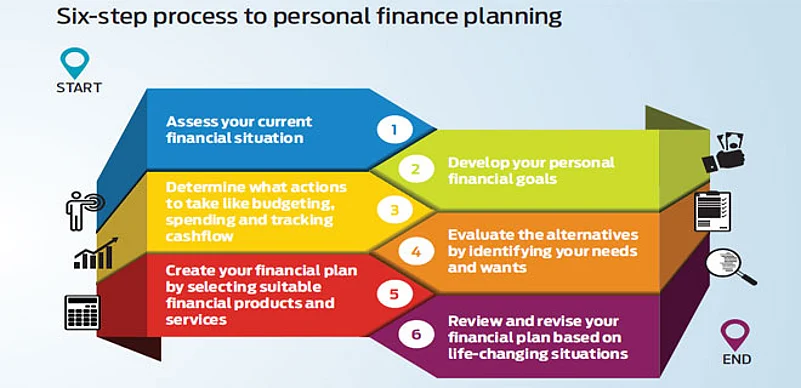In recent times, several readers have posted queries on the approach they need to adopt to set their financial goals and work towards achieving them. Typically, financial goals depend on the life stage one is in. For instance, over one’s life one will have goals like buying a house, buying a car, go on a family vacation, save for children’s education and one’s own retirement. Although these needs are fairly universal, yet, each individual’s goals would vary based on the money needed to achieve them and the time needed to reach each goal. Whatever is the stage of your life or circumstances, the process to achieve any financial goal is the same.
Step 1
Your current situation
Make a start by writing down your current financial situation. This could be by way of listing all your current assets and its monetary value and any liabilities that you may have by way of loans and outstanding sums you may be owing to anyone. This is the most important step and if you have a budget, it would be a cakewalk to get it all on paper. Write down your income, expenses, existing savings and existing investments with a value to each of these heads.
Steps 2
Chalk your goals
You should state all your financial goals and assign them a value and timeline by which you wish for it to materialise. Once you have the list, you can bucket them under different heads—short, medium or long-term. For instance, goals like purchasing an LED TV in three months is short term; family vacation that is three years later is a medium-term goal and your child’s education and your own retirement are long-term goals.
Step 3
Action plan
You need to now ascertain your comfort to risk, which is nothing but how much risk you can take when it comes to investing. For instance, if you are comfortable with 20 per cent erosion in value of your portfolio, you are a risk-taker. However, if you have sleepless nights when the value of your portfolio takes even a small dip, you are not a risk taker. The kind of risk that you can take will determine the type of financial instruments in which you can put money.
Step 4
Evaluating options
Link a savings and investment option for each of your financial goals. Doing so will ensure you do not mix your investments and are unable to prioritise funds for the many financial goals that you may have. This will also help in the selection of the appropriate financial instrument in suitable asset classes. Choose investments based on their tax efficiency and not be blinded by returns. For instance, you can deploy money in equity-oriented instruments to achieve goals that are over 5-7 years from now. Alternately, if the goals are between 2-3 years from now, you could look at parking money into debt instruments.
Step 5
Plan implementation
The next stage is to fix a regular sum to invest to achieve your financial goals, which will make goal-based investing a habit. Being regular with investments also gives you the convenience of achieving your financial goals smoothly.
Step 6
Review and revision
Investing for a financial goal is not a one-time exercise. To be on top of your finances, you should evaluate the progress made by your investments to achieve your financial goals at least once a year. This approach will help you understand how your investments are faring, with the opportunity to make any changes to them or restructure your plan if need be.
Last, as you approach closer to each of your financial goals, you should start moving money from equities to more stable debt-type of instruments. This way, you will not be impacted by any major impact to the stock markets, which are far more volatile and can upset your best laid plans.






























